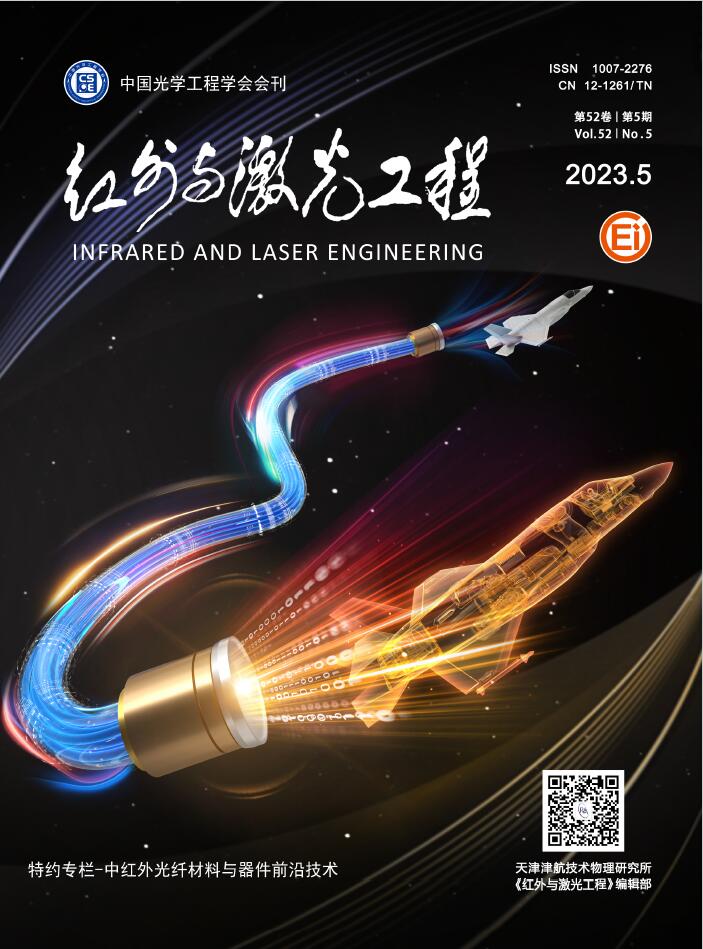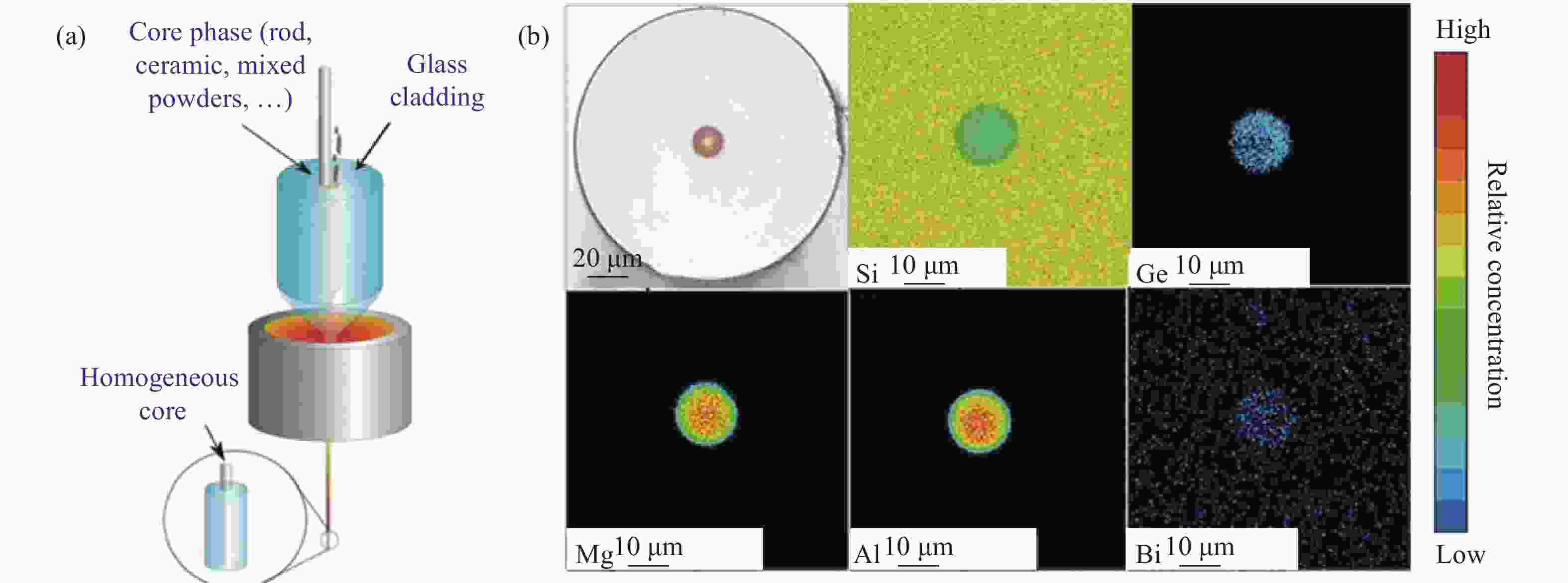-
当今社会,随着云计算、物联网以及大数据业务的兴起和普及,全球网络数据流量呈指数增长。信息化的加快也同样需要提高数据的传输能力和处理速度。因此,这就急需提高现有通信网络光纤的数据传输能力。目前,用于光通信系统的光纤激光器和光放大器多见于稀土离子掺杂玻璃光纤,如1 μm (Yb3+)、1.5 μm (Er3+)和2.0 μm (Tm3+和Ho3+)。然而,稀土离子的4f电子被外层屏蔽而很少受到外部晶体场的影响,表现出尖锐的发射光谱特性,具有较窄的发射带宽。而石英光纤作为光信号传输介质,其低损耗区域可覆盖1250~1650 nm。常用的掺铒光纤放大器,其光谱区域仅为~80 nm (1 530~1 610 nm)。而在1 150~1 500 nm的光谱范围内,更是不存在有效的稀土离子掺杂光纤激光器和放大器。故而,迫切需要探索新颖、高效、宽带可调谐的掺杂材料作为光纤增益介质,尤其是在1150~1500 nm的光谱范围内,以用于设计新型激光器和光纤放大器。
2001年,Fujimoto等人首次发现Bi在硅酸盐玻璃体系中能够发射近红外荧光,并有望用于宽带光纤放大器[1]。2005年,俄罗斯科学家Dianov等人利用改良的化学气相沉积法成功制备了第一根Bi石英光纤,并实现了1150~1300 nm范围内的连续激光输出[2]。至此,Bi掺杂玻璃光纤材料受到国内外研究者的广泛关注。Bi掺杂玻璃光纤已经在1150~1550 nm和1600~1800 nm范围内实现了激光输出和光信号放大[3-4]。这充分说明了Bi光纤有望成为下一代宽带光纤放大器和激光器以解决现有的通信容量“危机”。
文中将从Bi离子的近红外发光机理、Bi掺杂玻璃性能的提升以及Bi掺杂光纤的制备和应用三方面介绍Bi掺杂玻璃和光纤的最新研究进展。
-
Bi拥有完全不同于常见稀土元素(如Yb、Er、Tm等)的电子结构,其电子构型为(Xe)4f145d106s26p3,外部的6s和6p电子受基质玻璃影响,从而表现出依赖于基质玻璃的吸收和发射性质,同时也使Bi离子表现出多种价态,例如+1、+2、+3和+5[5]。这就使得无法准确地判断到底是哪种价态的Bi离子导致了Bi的近红外发光。目前,关于玻璃中Bi近红外发光中心的起源,存在多种假设:Bi团簇[6]、BiO[7]、Bi+[8-9]、Bi0[10-11]以及低价态Bi离子与氧空位结合的复合发光中心等[12]。不仅如此,在Bi5(AlCl4)3中也发现了Bi53+团簇可以实现中红外的发光[13-14]。尽管存在这么多基于实验探索为基础的假设,但仍然还需要大量的探究实验来确定Bi红外发光的确切来源。目前,普遍比较认可Bi的近红外发光来源低价态的Bi+和Bi0。
-
2005年, Meng等人在掺Bi磷酸盐玻璃中获得了Bi的近红外发光,根据吸收光谱获得了能级结构,基于能级匹配推测低价的Bi+离子可作为近红外发光中心[8]。如图1所示,他们将500、700、800、1000 nm的吸收峰归属于基态3P0~1S0、1D2、3P2和3P1的电子跃迁,而1000~1600 nm范围的发射则认为是3P1→3P0的电子跃迁。随后,Ren、Zhou等人均对Bi掺杂玻璃中的近红外发射进行了一系列研究,发现提高碱金属和碱土金属的含量会降低Bi的近红外发射,根据Duffy光学碱度理论,加高光学碱度有利于高价离子的存在,结合光谱特性和能级结构,他们皆认为位于1000~1600 nm的发射源于Bi+离子的3P1→3P0电子跃迁[15-19]。同时,为了更准确地证实Bi+是否是近红外发光中心,铋离子在晶体材料中的发光特性也得到进一步研究。Okhrimchuk等人报道了Bi:RbPb2Cl5晶体的近红外发光现象,通过对比该晶体的光谱能量数值和自由态Bi+、Bi2+的能级数据, 推断近红外发光中心为Bi+[20]。Su等人在被γ 射线辐照的α-BaB2O4晶体中实现了近红外宽带发光,根据吸收、激发和发射光谱,结合能级结构图,认为Bi+是其近红外发光中心[21]。Zhang和Zhou等人在Bi掺杂PbF2晶体中引入Yb3+和Er3+作为电荷补偿剂诱导Bi2+转换为Bi+,从而成功产生近红外发射[22-23]。

Figure 1. (a) Transmission spectra of Bi-doped phosphate glass; (b) Normalized emission spectra of Bi-doped phosphate glass excited by 405, 514, 808, and 980 nm, respectively; (c) Energy level diagram for Bi+ based on energy matching conditions[8]
-
氧化物Bi2O3作为Bi源是掺Bi玻璃的主要原料,在玻璃熔融过程中,随着温度升高,金属离子的氧化还原平衡会向还原侧移动。因此,Bi离子的价态会发生如下变化:
Bi3+→Bi2+→Bi+→Bi0→Bi clusters (e.g., Bi2, Bi2−, Bi3)→(Bi)n colloids
因此,Bi0也可以是Bi产生近红外发射的另一个潜在中心。2005年,Peng等人在Bi-Ta共掺的锗酸盐中实现了峰位位于1300 nm的近红外发光,半宽高超过400 nm,他们推断这种发光来源于Bi0团簇的发光[24]。随后,他们继续探索了室温下铋酸盐玻璃中宽带近红外发光起源。研究发现,铋酸盐玻璃的近红外吸收和发射特性表现出对熔化温度的依赖性。由于引入Bi2O3随着温度升高会逐渐分解为Bi原子,因此在1300 ℃熔化的铋酸盐玻璃颜色表现为深褐色,通过透射电子显微镜、高分辨率能量色散X射线光谱和元素分布图可以证实玻璃中存在Bi纳米粒子。通过与原子光谱数据比较,则将Bi掺杂玻璃在~320、~500、700、800、1000 nm处的吸收带归属为Bi0在4S3/2→2P3/2,4S3/2→2P1/2,4S3/2→2D5/2,4S3/2→2D3/2(2)和4S3/2→2D3/2(1)的跃迁,宽带近红外发射则来源于2D3/2(1)→4S3/2的电子跃迁[25]。2012年,Qiu等人在铋掺杂硼锗酸盐玻璃中通过改变激发波长实现了可调谐近红外发射,即在670 nm和820 nm激发时,分别出现了位于1 095 nm和1240 nm两个不同的发射峰,他们推测这两个发射峰分别归属于Bi+在3P1→3P0和Bi0在2D3/2→4S3/2的跃迁,且在470 nm激发时,这两个发射峰会重叠并产生一个新的1155 nm附近的宽带发射,这说明在铋掺杂玻璃中可以实现多个发光中心共存[26]。另外,Peng等人在Bi掺杂Ba2P2O7和Ba2B5O9Cl晶体中发现了宽带近红外发射,根据光谱特性、晶体结构、离子半径大小分析表明Bi原子只能占据Ba的位点,因此,推测晶体中的发光中心是Bi0[27-28]。2019年,Lu等人利用第一性原理计算对二氧化硅簇中是否存在间隙Bi0原子进行了理论研究。结果表明,间隙Bi0原子最有可能停留在距“Si-O-Si”六元环中心约2 Å的位置,且通过将跃迁能级与Bi0原子光谱数据进行比较,发现其2D3/2(1)→4S3/2的跃迁是导致Bi掺杂石英光纤中~1265 nm处近红外发射的主要来源,如图2所示[11]。

Figure 2. Calculated the differential charge density of interstitial Bi0 atom in 60-atom silica cluster model. (a) Map plane goes through Bi atom and two nearest Si atoms; (b) Map plane goes through Bi atom and two nearest O atoms; (c) Defect-free 96-atom supercell of fused silica model; (d) Interstitial Bi0 atom in 60-atom silica cluster model (Si atom is in gold, O atom is in red, Bi atom is in violet, and H atom is in white); (e) Calculated energy levels diagram of interstitial Bi0 atom in silica optical fiber, which are responsible for the NIR emission[11]
-
2001年,Bi的宽带近红外发光首次在硅酸盐玻璃中被Fujimoto等人报道[1],如图3所示,掺Bi玻璃在500 nm、700 nm和800 nm处表现出明显的吸收峰,同时在500 nm、700 nm和800 nm的激发下具有明显的宽带近红外发射,发光峰位分别位于1 140 nm、1 122 nm和1 250 nm处,范围覆盖1 000~1 600 nm,半高宽分别可达220 nm、160 nm和300 nm,表明其应用于宽带光纤放大器的巨大潜力[1]。随后,国内外开展了对Bi掺杂玻璃的研究热潮。2004年,Peng等人在Bi-Al共掺的锗酸盐玻璃中实现了1300 nm的宽带近红外发射[29]。2005年,Meng等人先后在掺Bi的磷酸盐和硼酸盐玻璃中获得了1000~1500 nm的宽带近红外发射[8-9]。2007年,Ren等人在铋掺杂的硫系玻璃中获得了1 000~1 450 nm的宽带近红外发射[30]。2009年,Peng等人通过控制熔融温度在铋酸盐玻璃中实现~1 230 nm处的近红外发光[25]。2011年,Romanov等人在氟化物玻璃中引入BiF3,利用氟化物具有强路易斯酸性有助于稳定低价铋发光中心,从而成功实现Bi离子在~1200 nm处的近红外发光[31]。然而,这些研究中Bi的近红外发光较弱,且多集中于O-band,难以覆盖在通信上有重要应用的S、C、L和U-band。因此,后续开展了一系列关于如何增强Bi掺杂玻璃近红外发光强度及拓宽其发射带宽的研究,以寻找适合光纤拉制的新型Bi激活玻璃。

Figure 3. (a) Transmittance spectrum of Bi-doped silicate glass; (b)-(d) Emission spectra of Bi-doped silicate glass under excitation at 500 nm, 700 nm, and 800 nm, respectively[1]
-
实现玻璃中高效发光是获得高增益光纤的关键,而在掺Bi玻璃中,Bi离子特殊的电子结构使其发光特性表现出对所处环境的高度敏感性,这为调控和增强Bi的发光提供了一些方法。
-
通过改变玻璃组分来调整玻璃结构从而调控Bi的近红外发光是一种获得高效发光掺铋玻璃的常见方法[32-34]。例如,网络中间体Al2O3是Bi发光中心重要的促发剂和分散剂,Al2O3以[AlO4]四面体进入玻璃网络,一方面可以补强玻璃网络,稳定Bi近红外发光中心,另一方面也可以构造带负电荷的局域环境迫使更多Bi+中心产生,从而有效增强掺Bi玻璃的近红外发射,如图4(a)所示[35-37]。另外,硼酸盐玻璃声子能较高(1400 cm−1),且由[BO4]四面体和[BO3]三角体构建的疏松玻璃网络结构,因此,导致掺Bi的硼酸盐玻璃发光较弱。而引入低声子能的氧化锗(900 cm−1),则可以降低Bi离子的无辐射跃迁,同时[GeO4]四面体也可以补强玻璃网络,稳定Bi发光中心,使掺Bi硼锗玻璃比掺Bi硼酸盐玻璃具有更强的近红外发光(图4(b))[38]。而在锗酸盐玻璃中引入氧化硅形成杂化玻璃网络同样也可以有效增强Bi的近红外发射(图4(c))[39-40]。不仅如此,玻璃结构的调控往往也会在一定程度上改变发光带宽、峰位及荧光寿命。例如,图4(b)中,当氧化锗逐渐替换氧化硼时,其半高宽从~200 nm增加到350 nm。图4(d)中,Xue等人逐渐增加掺铋硼酸盐玻璃中的氧化钙时,其发光峰位可从1200 nm红移至1285 nm,从而可以较好地覆盖通信O-band[41]。

Figure 4. (a) Effect content of Al2O3 content on the NIR emission spectra of Bi-doped germanate glasses[35]; (b) Effect of GeO2 content on the NIR emission spectra of Bi-doped borate glasses[38]; (c) Effect of GeO2 content on the NIR emission spectra of Bi-doped silicate glasses[39]; (d) Effect of CaO content on the NIR emission spectra of Bi-doped borate glasses[41]
-
考虑到掺Bi玻璃中产生近红外发光主要来自低价的Bi离子,因此在玻璃网络中构造局域还原环境以诱导形成更多低价Bi离子近红外发光中心成为获得高效发光玻璃的另一有效手段。Liu等人在掺Bi硼酸盐玻璃中引入C粉作为还原剂,相对于未含C粉的玻璃样品,玻璃样品的吸收和发射强度均有大幅度提升(图5(a))[42]。Zhang等人通过将Bi激活中心稳定在多孔玻璃中,分别在空气、氢气和氦气气氛下处理玻璃样品,发现He气处理的玻璃样品其近红外发射得到明显加强(图5(b))[43]。Cao等人发现在掺Bi玻璃中引入氮化物(AlN,Si3N4)作为新型还原剂,在不改变玻璃网络结构的前提下,微量的AlN或Si3N4就能大幅度增强Bi的近红外发光强度(图5(c)~(d))[44-45]。

Figure 5. (a) NIR emission spectra of Bi-doped borate glasses with different carbon content (λex = 450 nm), the inserts are the images of glass samples[42]; (b) NIR emission spectra of samples PGB1 and PGB3-6 pumped by 980 nm treated under different atmosphere[43]; (c) Comparison between the emission spectra of the Bi single doped and Bi-AlN co-doped glass samples (λex = 467 nm) [44]; (d) NIR emission spectra (λex = 468 nm) of Bi-doped Nx samples (x = 0-0.1 mol%) with Si3N4 content varying[45]
-
高能射线可以在辐照区域中产生光电子来触发光激活氧化还原化学反应(hν + An+ → A(n+1)+ + e−;Bp+ + e− → B(p-1)+),从而可以原位调控离子价态[46-47]。因此,研究者开展了一系列利用飞秒激光和γ等高能射线辐照Bi掺杂玻璃增强其近红外发射强度的研究[48-50]。Wang等人利用飞秒激光辐照含Bi的硼酸盐玻璃,成功利用光激活氧化还原反应将高价的Bi3+离子还原成低价的近红外Bi发光中心[51]。飞秒激光作用后,玻璃在1000~1600 nm范围内的近红外发射显著增强,且随着激光脉冲能量从2.0 μJ增加到 8.0 μJ,发光分强度别提高了15、36、76、174 倍,如图6所示。

Figure 6. (a) Optical microscope image of grating under 6.0 μJ of fs laser pulse energy, and photographs of various sample irradiated under different pulse energy (0-8.0 μJ, as labeled); (b) Absorption and (c) NIR emission spectra (λex = 808 nm) of the glass samples under different fs laser pulse energy[51]
-
目前,Bi掺杂玻璃材料在1000~1600 nm范围内一般只表现出单带发射,发射峰集中在O-band,位于1300 nm以前,而常用的通信C、L、U-band却只有光谱尾部能覆盖。因此,拓展Bi掺杂玻璃的光谱带宽以开发新型超宽带光纤放大器用于解决现有通信容量危机具有重要意义。目前,光谱拓宽主要通过以下方式来实现。
-
在玻璃中共掺稀土离子是掺Bi玻璃中拓展带宽最直接的方法,且已被大量研究所证实。Qiu等人制备了Bi-Er共掺硅酸盐玻璃,在900~1800 nm范围内表现出Bi离子和Er离子的典型发射,半宽高为450 nm,可覆盖通信O-U bands,可用于研制超宽带光纤放大器(图7(a))[52]。另外,他们也成功制备了Bi与多稀土离子共掺的宽带发射的红外玻璃,如Bi-Er-Nd共掺玻璃实现了1 000~1 700 nm宽带发光,且在1 060、1 270、1 540 nm表现出明显的特征发射峰,而Bi-Er-Tm共掺玻璃更是将发射范围拓展到2 000 nm,覆盖了O-U整个通信波段(图7(b)~(d))[53-54]。

Figure 7. (a) NIR emission spectra of Bi, Er single-doped glass, and Bi-Er co-doped glass under the excitation of 808 nm LD[52]; (b) NIR emission spectra of Bi, Er, Nd single-doped glass, and Bi-Er-Nd co-doped glass under the excitation of 808 nm LD[53]; (c) NIR emission spectra of Bi, Er, Tm single-doped glasses under the excitation of 808 nm LD; (d) NIR emission spectra of Bi-Er-Tm co-doped glass under the excitation of 808 nm LD[54]
-
由于Bi在玻璃中可以以多种价态、团簇、抑或是复合物发光中心存在,因此受离子共掺启发,可以在玻璃中诱导产生多种Bi中心共存以实现超宽带的近红外发射。Cao等人在Bi掺杂硼酸盐中引入GeO2,成功诱导出Bi+和Bi0两种发光中心,使光谱半宽高从210 nm增加到352 nm,如图8(a)所示[33]。另外,Cao等人在锗酸盐玻璃中引入AlN或者SiC,诱导了两个新的发光带,即~920 nm和~1500 nm,使玻璃中稳定存在多种Bi近红外发光中心,从而产生了覆盖800~1600 nm的超宽带发光,如图8(c)~(d)所示[55-56]。同样地,Chen等人通过金属还原策略也可以在Bi掺杂玻璃中实现这种多中心共存的超宽带多模式近红外发光[57]。

Figure 8. (a) Normalized emission spectra at emission peak ~1140 nm of Bi‐doped borate glass samples with elevating GeO2 content[33]; (b) Comparison between the emission spectra of Bi-doped germanate glass samples 0 SiC and 3 SiC by Gauss fitting[56]; (c) Comparison of the emission spectra of Bi-doped germanate glass samples without AlN (N0B0.02), with AlN (N2B0.02), and with 3 mol% Bi (N0B3)[55]
-
在开展对Bi激活近红外玻璃研究的同时,对Bi掺杂光纤的研究也在持续进行,并取得了大量的研究成果,主要分为探索不同的Bi光纤制备方法,提升Bi光纤的性能以及拓展Bi光纤的工作波长。
-
改良的化学气相沉积法(Modified Chemical Vapor Deposition,MCVD)是一种在高质量的石英基管内部沉积更高纯度的SiO2,并掺入可调节折射率或改变粘度的其他高纯物质(如GeO2、P2O5、SiO1.5F等),从而获得具有不同折射率芯层和包层的光纤预制棒制备方法(图9(a))。这种方法灵活性强,原料的纯度可控,制备的光纤纯度较高,损耗较低,现已成为高品质通信光纤用预制棒的主要方法之一[58]。2005年,Dvoyrin V V等人利用MCVD法成功制备了第一根Bi光纤[59]。至此开启了对Bi光纤的研究热潮。考虑到Bi离子发光特性,通过在光纤中共掺入不同的元素(Al、P、Ge)从而可以获得不同工作波段的铋光纤(图9(b))[2, 60-63]。
-
熔芯法,也叫管内熔融法和纤芯熔融法,早期概念于1995年由Ballato等人首次提出[64]。这种方法制备光纤的基本特征是:在光纤高温拉制过程中,包层处于软化状态,而纤芯处于熔融态,且在高速拉丝过程中可快速冷却,跨过析晶温度点,从而可成功将光纤预制棒拉制成光纤,如图10(a)所示[65-66]。这种方法破除了需要同质芯包材料的限制,只要满足拉制温度和折射率条件则可成功拉制成相应的光纤,极大地拓展了预制棒中芯包材料的选择(如陶瓷、玻璃、粉体、金属等均可作为纤芯材料)。这同样也推动了研究人员对Bi掺杂多组分玻璃光纤的探索。2016年,Fang等人利用熔芯法,以Bi掺杂硅酸盐多组分玻璃为纤芯,高纯石英玻璃为包层,成功拉制铋光纤,光纤芯包界面清晰,如图10(b)所示[67]。
-
管棒法是另一种常见的光纤制备方法,如图11(a)所示,分别熔制大块纤芯玻璃和包层玻璃,再按目标芯包比加工成合适尺寸的纤芯棒和包层套管,将纤芯棒插入包层套管中组成预制棒,再经拉丝塔升至合适温度拉制成相应光纤。目前,已经在多组分玻璃体系如硼酸盐、磷酸盐、硅酸盐、锗酸盐、碲酸盐、氟化物等得到应用且成功拉制成相应光纤[3]。2017年,Zhang等人研制了一种高Bi浓度掺杂,热稳定性优异的锗酸盐玻璃,并利用管棒法成功拉制了相应Bi掺杂锗酸盐多组分玻璃光纤(图11(b))[68]。2018年,Cao等人在掺Bi锗酸盐玻璃中引入AlN提高了玻璃的热稳定性,随后利用管棒法成功拉制出芯包界面明显的Bi光纤[55]。

Figure 11. (a) Preparation process of Bi-doped fiber by the rod-in-tube technique; (b) EPMA-WDS mappings of different elements from the Bi-doped fiber cross section[55]
-
目前,大部分掺Bi光纤均是基于MCVD法制备的石英基光纤,且通过调整纤芯组分可以在Bi掺杂光纤中实现800~1800 nm范围内的超宽带发光,如在Bi掺杂铝硅酸盐光纤(Bi-doped aluminosilicate fiber, BASF)中荧光峰位于1150 nm、Bi掺杂磷硅酸盐光纤(Bi-doped phosphosilicate fiber, BPSF)中荧光峰位于1300 nm,Bi掺杂锗硅酸盐光纤(Bi-doped germanosilicate fiber, BGSF)中荧光峰位于1450 nm和Bi掺杂高锗(GeO2 ≥ 50 mol%)硅酸盐光纤(Bi-doped high germane-silicate fiber, BHiGSF)中荧光峰位于1700 nm[69]。因此,基于不同纤芯组分的掺铋石英基光纤则开发了一系列不同波段的光纤激光器和放大器。
-
2005年,Dianov等人在BASF中首次实现了1150~1300 nm范围内中心波长分别为1146、1215、1250、 1300 nm的连续激光输出[2]。随后,在2007年,他们又在BASF中实现了输出功率为15 W,斜率效率为22%,中心波长为1160 nm的激光输出[70]。因为BASF中实现的激光波长多在1300 nm以前,难以有效覆盖通信波段。研究发现,如果将纤芯中的Al用P或Ge代替,则可拓宽Bi的近红外发光。随后,Thipparapu等人制备了BPSF,并在构建的环形腔中利用1270 nm双泵浦在光纤中成功实现了输出功率为22 mW,中心波长为1360 nm的激光输出[71]。Dvoirin等人则在BGSF中实现了中心波长为1430 nm的激光输出[72]。此外,当在BPSF的纤芯中引入少量Ge时,可得到Bi掺杂含磷锗硅酸盐光纤(BPGSF),其发光带宽更宽,可覆盖整个1300~1550 nm波段。Bufetov等人成功制备了BPGSF,并在多个泵浦源下首次实现了1300~1470 nm范围内的激光输出[73]。Dianov等人在BPGSF中首次实现了1470~1550 nm 的激光输出[74]。除此之外,Bi掺杂纯石英光纤也能获得功率为22 W,中心波长为1460 nm的激光输出[75]。至此,已经在Bi掺光纤中实现了1300~1550 nm范围内的激光输出,可覆盖O、E和S波段以及部分C波段。如前所述,在Bi光纤的纤芯中引入Ge可拓宽其近红外发光范围。研究者发现将Bi光纤纤芯中Ge的浓度提高到50 mol%以上,则可以获得1600~1800 nm的近红外发光。2014年,Dianov等人首次BHiGSF实现了中心波长为1625、 1688、1703、1735、1775 nm的连续激光输出[76]。随后,Firstov等人将1700 nm的激光输出功率提升到1.05 W,斜率效率可达33%[77]。
-
研究者在对Bi光纤激光的探索过程中,同时也开展了一系列Bi光纤放大器的研制。2009年,Dianov等人在BGPSF实现了1320 nm处24.5 dB的增益,增益带宽为37 nm。2011年,Melkumov等人在Bi掺杂BGPSF中将增益波长延伸到1440 nm,增益达到24 dB,3 dB带宽为40 nm,噪声指数为6 dB[78]。同年,Chapman等人在BASF中观察到1160 nm处超过20 dB的小信号增益[79]。另外,Bufetov等人首次在Bi掺杂石英光纤中实现1440 nm处8 dB的信号放大。2015年,Thipparapu等人在BPSF中采用波长为1240 nm和1267 nm 的LD激光器双向泵浦,在1320~1360 nm范围可获得(25±1) dB的平坦增益,带宽超过40 nm,噪声系数小于5 dB。随后,他们通过改变泵浦方案在BPSF中可使1360 nm的增益达到40 dB,这也是迄今为止报道的Bi掺杂光纤放大器的最高增益[80]。2021年,Thipparapu等人继续优化了BPSF的泵浦方案,在O-和E-band (1345~1460 nm)范围内实现了覆盖115 nm超宽带宽的增益放大(>20 dB),这是迄今为止Bi掺杂光纤放大器实现的最大增益带宽[81]。2016年,Firstov等首次实现BHiGSF在1640~1770 nm范围内的信号放大,在1710 nm处获得了最大增益23 dB,3 dB带宽为40 nm,噪声系数为7 dB[82]。2020年,Dvoyrin等人利用BGSF也实现了1425~1500 nm范围内的信号放大,其中在1445 nm处的最大增益为27.9 dB[83]。2022年,Nikodem等人利用BHiGSF实现了1687 nm处26 dB的增益放大[84]。同年,国内胡丽丽研究团队通过MCVD法制备了BPSF,采用两个1240 nm的激光器以总功率870 mW进行双向泵浦,输入−30 dBm的1355 nm信号光,在170 m光纤中实现了接近20 dB的增益,这也是国内首次在Bi掺杂光纤中实现光信号放大[85]。
另外,图12和表1总结了目前Bi光纤激光器和放大器的所实现的最大输出功率和信号增益[69, 86]。由此可知,Bi光纤激光和放大器的波长可以覆盖1160~1775 nm区域,不仅包括稀土激活光纤激光所能覆盖的区域,而且也弥补了当今光纤激光在其他通信波段的空白。因此,Bi光纤已然成为新一代激光介质,在超宽带光放大器及可调谐激光器领域展示出重大潜力。
Bi fiber λpump/nm Gain band/nm Maximal gain/dB Bi content Length/m Method Year Ref. BASF 810 1260-1300 5.8 @1308 nm 2 mol% 0.08 Rod-in-tube 2006 [87] 810 1310 9.6 2 mol% 0.05 Rod-in-tube 2007 [88] 1060 1160 6.3 0.002 mol% 30 MCVD 2011 [79] 1180 5.5 1120 1180 8 dB - 100 MCVD 2015 [89] BPSF/BPGSF 808 1260-1360 5 @1380 nm 0.1 wt% 13 MCVD 2008 [73] 1230 13 @1380 nm 1230 1280-1370 25 @1320 nm <0.02 at% 200 MCVD 2010 [90] 1318 1420-1600 21 @1440 nm 810 1260-1360 2 @1340 nm - 4 MCVD 2011 [91] 1267+1240 1320-1360 29 @1340 nm <0.02 at% 100 MCVD 2016 [92] 1155-1235 1272-1310 19 @1296 nm <0.01 mol% 80 MCVD 2019 [93] 1240+1270 1300-1360 40 @1360 nm <0.02 at% 152 MCVD 2019 [80] 1178 1287-1354 30 @1270 nm <0.02 at% 125 MCVD 2020 [94] 1270+1310 1345-1460 31 @1420 nm <0.02 at% 220 MCVD 2021 [81] BPSF
(Domestic)1 240 1355-1380 5 @1355 nm 0.02 wt% 85 MCVD 2022 [85] BSF/BGSF 1 230 1 420-1 550 8 @1 440 nm <0.05 mol% 15.2 Molten core 2011 [95] 1 310 1 350-1 650 34 @1 427 nm <0.1 wt% 125 MCVD 2011 [78] 1 330-1 350 1 425-1 500 28 @1 460 nm - 400 MCVD 2020 [83] BHiGSF 1 550 1 640-1 770 23 @1 710 nm 0.018 wt% 50 MCVD 2016 [82] 1 550 1 651 18 0.018 wt% 90 MCVD 2018 [84] 1 687 26 
Figure 12. Output power, peak position and corresponding excitation wavelength of Bi doped fiber laser[86]
-
多年来,对于Bi掺杂玻璃和光纤,无论是在理论上,还是制备方法、性能优化以及实际应用均取得了显著的成果,这些都为研制新型、宽带、高效、可调谐的激光器和放大器奠定了基础,也非常符合未来大容量高速度光通信的发展需求。
然而,Bi光纤激光也存在一些问题。目前所制备的Bi光纤中Bi的掺杂浓度非常低,从而导致需用较长的光纤长度才能实现有效的激光输出和光信号放大,这不利于器件的集成化。其次,MCVD法制备的Bi光纤均是基于石英基质,且需要极高的温度(>2000 ℃),这将导致Bi光纤中Bi的严重挥发。并且,Bi近红外发光中心的形成对温度、气氛以及Bi掺杂浓度等工艺参数非常敏感,从而较难在其他光纤制备技术中获得有效稳定的Bi光纤。因此,需要通过优化玻璃组分,探索新方法实现低Bi浓度掺杂下的高效发光,推动Bi光纤和激光的实际应用。
此外,鉴于目前关于研制Bi掺杂多组分光纤的报道较少,且仍没有在多组分玻璃光纤中实现Bi激光输出和光信号放大,急需通过新技术、新方法探究可实现高效、稳定、宽带近红外发光,且适合拉制光纤的Bi掺杂多组分玻璃,再利用传统的熔芯法或管棒法在更低的温度拉制成相应的Bi掺杂多组分光纤,继而实现Bi光纤激光。这将为Bi光纤激光的实用化,以及Bi光纤激光器和放大器的商业化开辟一条崭新的道路。另外,最大的问题就是对于Bi的近红外发光机理尚不清楚,仍需要探索新理论、新方法进行分析来阐明Bi离子掺杂发光材料的发光机制。尽管Bi掺杂玻璃光纤材料还存在不少问题,但这既是机遇也是挑战,相信通过大量的实验探索结合理论验证可以有效地解决这些问题。
Research progress on ultra-broadband luminescence of Bi-doped glass and fiber (invited)
doi: 10.3788/IRLA20230097
- Received Date: 2023-02-27
- Rev Recd Date: 2023-03-25
- Publish Date: 2023-05-25
-
Key words:
- ultra-broadband /
- infrared luminescence /
- Bi-doped glass /
- Bi-doped fiber
Abstract:












 DownLoad:
DownLoad:










